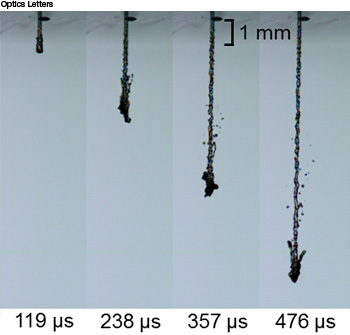
A time-lapse image showing a microjet fired from the laser-based injection system. Traveling through the air, the liquid in this experiment reaches a velocity of 30 meters per second (nearly 100 feet per second).
Nobody likes getting a medical injection, and some people have a phobia toward needles. In the future, a laser-powered injection device might be able to shoot vaccines and medications into the skin with less pain and no needle (Opt. Lett. 37, 3894).
Jack J. Yoh and his colleagues at Seoul National University (South Korea) devised a transdermal drug-delivery device that sends a narrow jet of liquid out of a tiny nozzle held a few millimeters from the surface of the skin.
The impetus for that jet comes from a 2.9-µm Er:YAG laser with a pulse duration of 250 µs. Since water strongly absorbs light at this wavelength, the laser energy raises the temperature of the liquid drug until a vapor bubble suddenly appears. The explosive expansion of the bubble propels the drug through a tiny jet nozzle and into the skin.
The jet is only about 150 µm wide, which is about half the diameter of the needles on some commercially available insulin syringes. However, in these experiments the fluid jet, containing a fluorescent stain, easily penetrated skin samples from guinea pigs.
Unlike some proposed jet-injector drug-delivery systems, Yoh’s device has no mechanical piston or other moving parts that can cause “splashback,” a potential source of cross-contamination.
The nozzle needs to be less than 3 mm from the skin surface to avoid atomization of the tiny jet stream due to turbulence in the air. The nozzle opening has an outer ring (a couple of millimeters in front of the nozzle tip) that touches the skin and provides a distance guide.
In the proof-of-concept experiments, the device delivered dosages of 500 nl—three orders of magnitude smaller than a typical vaccine dose. In subsequent work, the team has quadrupled the amount of fluid injected into the skin, and Yoh says that the pulsed laser syringe could eventually deliver the entire dose.
The jet targets the skin layer above the nerve endings, so it should not cause the drug recipient any pain, according to Yoh. He says the next steps in the research are to prepare for clinical trials and to develop packaging to make the device easy for medical professionals to use.
